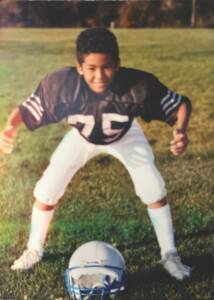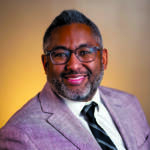TEAMWORK AND STRUCTURE
By Ron Ransom Butler ’00
Heavy raindrops fall from the sky on a crisp Saturday morning. A wide-eyed, slender 7-year-old boy stands on the sideline of a dampening field. His helmet sits snugly on his head, and his white pants are immaculately spotless — a clear indication he has yet to see a second’s worth of the action. As the game draws to its close, with a lopsided score decided long ago, the coach’s voice rings down the sideline, “Ransom, you’re in on the next play.”
That was my first year of football, and in my mind, I already had decided it would be my last. Why keep doing something if I wasn’t any good? Why keep showing up to practices and games, only to serve as a practice dummy or warm the bench? Those thoughts lingered in my mind for the rest of the year. But one day in early August, something shifted. I woke up and decided to give it another try. Over the next nine years, I improved. I played through high school, and the lessons I learned — both on and off the field — became invaluable to me long after I hung up my helmet and stopped putting on the pads.
When I got to college, I quickly realized something was missing. By the spring semester, I joined Phi Kappa Psi. It became clear that it wasn’t the early morning two-a-days in the sweltering heat of summer or the smell of the locker room after practice that I longed for — though, admittedly, the fraternity house carried a similar aroma, enhanced by the lingering scent of stale beer. As my time in the Fraternity went on, I realized that what I truly missed was the structure — the rhythm of practices and the thrill of preparing for the next game. I missed the competition that kept me sharp and, most importantly, the camaraderie. The friendships that went far beyond the field. I missed the off-season weight room sessions, weekends spent watching football with the guys, joking in the hallways between classes, and 10-cent wing nights that brought us together like family.
What I have come to understand both through football and my time in the fraternity, is that the value of these experiences goes far beyond the surface. Sports are about so much more than just the games being played on the field. They’re a testament to the countless people working behind the scenes — the coaches who mentor, the administrators who organize, the families who cheer from the stands, and the fans who create an atmosphere of excitement and belonging. These roles all contribute to something greater: a shared sense of community, purpose, and identity.
 Similarly, a fraternity thrives because of the same interconnected efforts. It’s not just weekly meetings, formal rituals, or the social events that define it, but the people — the brothers who support one another, the advisors who guide, and the alumni who give back to ensure the legacy continues. Just like in sports, a fraternity is a network of individuals who each play a role in creating something larger than themselves.
Similarly, a fraternity thrives because of the same interconnected efforts. It’s not just weekly meetings, formal rituals, or the social events that define it, but the people — the brothers who support one another, the advisors who guide, and the alumni who give back to ensure the legacy continues. Just like in sports, a fraternity is a network of individuals who each play a role in creating something larger than themselves.
For this edition of The Shield, we are proud to highlight some of our members who are making their mark in sports —whether as athletes on the field, coaches on the sidelines, or professionals in their respective careers across the country. Their contributions extend far beyond the wins and losses, embodying the values of teamwork, resilience, and community that unite us all. Whether on the field or within the walls of a fraternity house, the benefits are clear and impactful. These spaces teach us how to collaborate effectively, push through challenges, and rely on one another in meaningful ways. They create connections that bring people together, fostering lifelong bonds that not only enrich our personal lives but also the communities in which we proudly serve.
Ronald K. Ransom II



